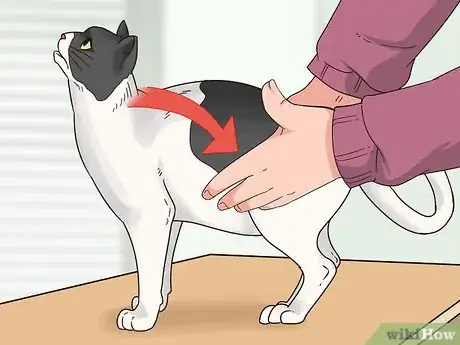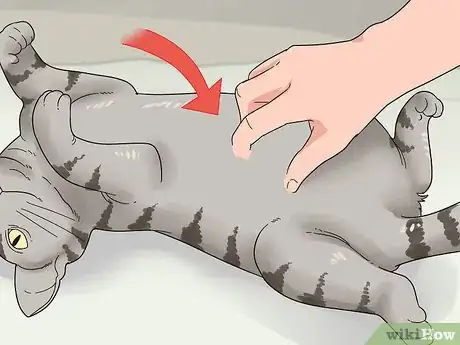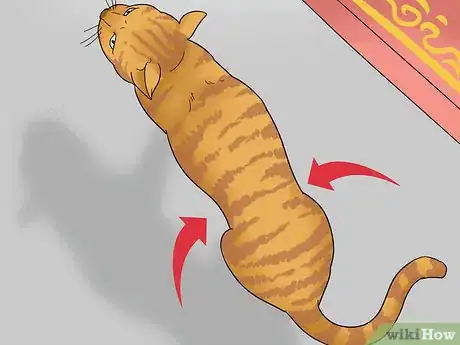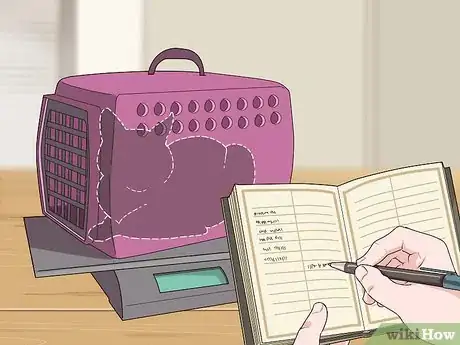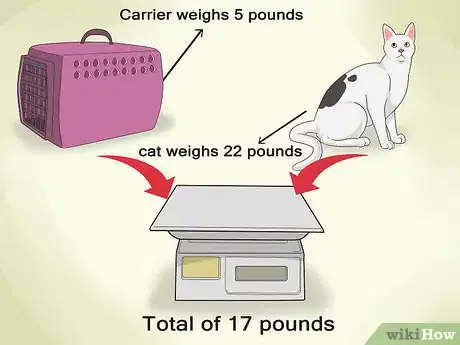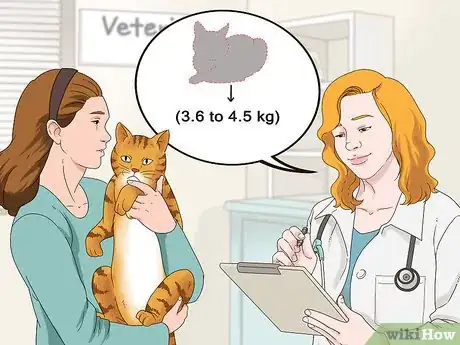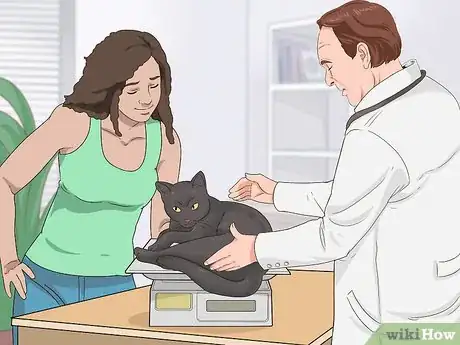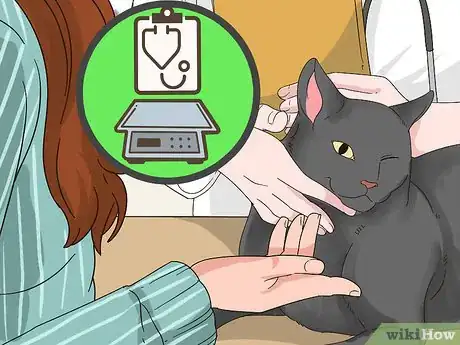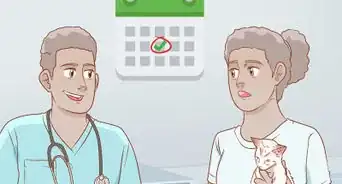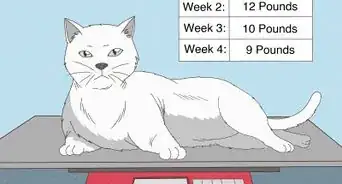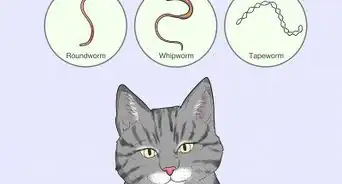This article was co-authored by Ryan Corrigan, LVT, VTS-EVN. Ryan Corrigan is a Licensed Veterinary Technician in California. She received her Bachelor of Science in Veterinary Technology from Purdue University in 2010. She is also a Member of the Academy of Equine Veterinary Nursing Technicians since 2011.
There are 7 references cited in this article, which can be found at the bottom of the page.
This article has been viewed 33,520 times.
Knowing your cat’s weight is an important way to monitor your cat’s health. You may be able to assess its weight by using your hands to feel for its rib cage, as well as by visually assessing your cat from the side and from above. Additionally, you can weigh your cat at home on a regular scale to obtain its weight. If you cannot assess your cat’s weight by yourself, then take your cat to the vet.
Steps
Using Your Eyes and Hands
-
1Feel for your cat’s ribs. Have your cat in a standing position and kneel behind it. Place your thumbs on its backbone and spread your hands down over its ribcage. Then feel for your cat’s ribs.[1]
- You should be able to feel your cats ribs, but they should not be visible with your naked eye. If your cat’s ribs, spine, and pelvic bone are visible, then your cat may be underweight.
- If a thin or thick layer of fat is preventing you from feeling your cat’s ribs, then it may be overweight or obese.
-
2Look for a tucked up abdomen. Do this by viewing your cat from the side, i.e., its profile. Get on your hands and knees to view its profile from an even level. Your cat’s abdomen should tuck up in front of its hind legs. Its underbelly, i.e., flank fold, should also be present.[2]
- If your cat’s abdomen tucks up sharply and an underbelly is not present, then it may be underweight.
- If your cat’s abdomen only tucks up slightly (or not at all) and its underbelly wobbles or sways when your cat walks, then it may be overweight.
Advertisement -
3Observe your cat's waistline. Do this by viewing your cat from above while it is in a standing position. Try to observe a visible waistline in the space between its ribcage and hindquarters. Look for a slight narrowing in this area.[3]
- If your cat’s waist dramatically narrows behind its ribcage, then your cat may be underweight.
- If your cat has little or no waistline and its back broadens, giving it a rounded shape, then it may be overweight.
-
4Reference a feline body fat index (BFI) chart. A BFI chart will feature pictures of cats with different amounts of body fat so you can see where your cat fits in. The chart will also tell you which things to look for on your cat's face, sternum, and tail to determine its weight.[4]
- You can find a feline BFI chart at https://todaysveterinarypractice.com/wp-content/uploads/sites/4/2015/02/Hills_BFIRiskChart_DogsCats_4-pages.pdf.
Weighing Your Cat at Home
-
1Place your cat in its carrier. Position the carrier on its end with the entrance facing the ceiling. Then pick up your cat by placing one hand under its front legs and one hand under its bottom. Starting with your cat's backend, lower it into the carrier. Close the door and place the carrier in its correct position.[5]
- If your cat becomes anxious at the sight of its carrier, then try holding your cat instead of placing it in a carrier.
-
2Weigh the carrier. Do this by placing the carrier with your cat in it on the scale. Then record the weight and take your cat out of the carrier.[6]
- If you are holding your cat, then stand on the scale and record the weight.
-
3Place the carrier on the scale. Record the weight of the carrier without your cat in it. Then subtract the weight of the carrier from the weight of the carrier with your cat in it. The resulting number is your cat’s weight.[7]
- For example, if the carrier plus your cat weighs 22 pounds and the carrier weighs 5 pounds, then subtract 5 from 22 to get a total of 17 pounds.
- If you don't have a carrier, you can just hold your cat while standing on the scale and write down the weight. Then, subtract your own weight from the total (your weight plus the cat’s weight) to get your cat’s weight.
Consulting Your Vet
-
1Compare your cat's actual weight to its ideal weight. Do this to see if your cat is underweight, overweight, or at a normal weight. Ideally, a domestic cat weighs 8 to 10 pounds (3.6 to 4.5 kg). However, a cat’s ideal weight depends on its breed and body type. Therefore, you may need to consult your vet to see how your cat's weight compares to the ideal weight for its breed and body type.[8]
- For example, 10 to 25 pounds (4.5 to 11.3 kg) is the ideal weight for Maine Coon cats, 7 to 12 pounds (3.2 to 5.4 kg) is ideal for Persian cats, and 5 to 10 pounds (2.3 to 4.5 kg) is ideal for Siamese cats.
-
2Take a trip to the vet. Do this if your scale at home cannot register your cat’s weight, or if you are still unsure after assessing its weight visually and manually. Your veterinarian will use a body condition scale to accurately assess your cat’s weight.[9]
- Make sure to consult your vet before implementing any kind of diet plan.
- If your cat is overweight, your vet may recommend dietary changes or prescribe your cat a special kind of food.
-
3Check your cat’s weight periodically. Do this to monitor your cat’s health. Rapid weight gain or loss may be a sign of disease or illness. Take your cat to the vet immediately if you notice any sudden changes in weight.[10]
References
- ↑ https://www.purina.com/cats/understanding-cat-food/is-my-cat-her-ideal-weight-or-overweight
- ↑ http://agriculture.vic.gov.au/pets/cats/cat-health/cat-condition-score-chart
- ↑ http://agriculture.vic.gov.au/pets/cats/cat-health/cat-condition-score-chart
- ↑ http://www.baysidecatresort.com.au/blog/10-do-you-have-a-cat-of-generous-proportions.html
- ↑ https://www.banfield.com/pet-healthcare/additional-resources/article-library/safety-tips/a-guide-to-getting-your-cat-in-a-pet-carrier
- ↑ https://www.youtube.com/watch?v=kt6y4qFUWx4
- ↑ https://www.youtube.com/watch?v=kt6y4qFUWx4
- ↑ http://petobesityprevention.org/ideal-weight-ranges/
- ↑ http://www.vetstreet.com/care/keeping-your-pet-at-a-healthy-weight
About This Article
An easy way to asses your cat's weight is by placing your thumbs on its backbone and spreading your hands down over its rib cage. If your cat is at a healthy weight, you will be able to feel its ribs, but they won't be visible to the naked eye. Next, get close to the ground and examine your cat's abdomen from the side. The abdomen should tuck up in front of its hind legs and the underbelly should be visible. If your kitty's abdomen tucks up sharply and there's no underbelly, it might be underweight. If it doesn't tuck at all and the underbelly wobbles when it walks, your kitty is overweight. For tips on weighing your cat with a scale, read on!
